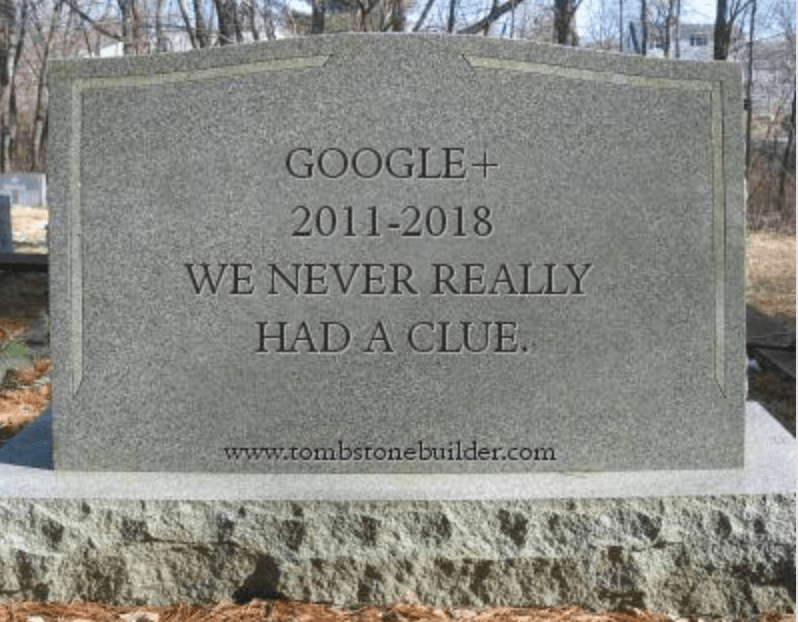
By Mark Schaefer
I don’t think there has ever been a day filled with more excitement and anticipation than that time seven years ago when Google launched Google+. The company doled out private invitations, leaving the masses eager to gain access and we all scoured the web looking for invitations. The Facebook killer!
A handful of my friends even bet their careers on Google+. It seems strange now, but they actually specialized in Google+ consultancies and training for businesses. Even as the decline seemed inevitable, they vigorously defended the platform as a more refined and business-friendly social network.
But just a few years later, all of that seems dream-like. After millions of dollars of investment, Google abandoned the effort to take on Facebook.
The day Google+ launched — before I ever tried it out — I wrote a blog post predicting it would fail. I was absolutely skewered by the rest of the social media bloggers, but as it turns out, the reason i thought it would fail was spot-on.
As we bury our old friend today, let’s reflect on three critical lessons from this Google failure that are applicable to any startup.
1) Switching costs
The primary reason i predicted that Google+ would fail was that Facebook was already so dominant that the psychological switching costs of moving to the new platform were too high.
I had pointed out in a post pre-dating G+ that it would be easier for most people to move into a new house than to switch their social network. Moving to Google+ meant you would also have to move your tribe there too.
We didn’t need a new social network because the one we had worked just fine. We don’t need another Twitter. We don’t need another LinkedIn. And we didn’t need another Facebook.
But even with this huge challenge of taking on the dominant player, I do believe Google had a chance with the proper strategy. They needed to execute in two areas, but they failed there, too:
2) No significant IP
The first strategic failure was that G+ didn’t solve a unique problem. It was a wonderful collection of technical capabilities in a clean design, but there was no “must-have” idea there.
In the early days of Google+, can you guess who the biggest power user of the network was? The person with the most followers? Mark Zuckerberg. Why? Because he wanted to copy whatever G+ was up to.
To take on Facebook, Google had to have some meaningful intellectual property that it could protect, some whiz-bang idea that would draw the masses. The closet thing they had to that was video chat functionality, but again, this was something you could do in other places. It wasn’t a unique draw or a technology that couldn’t be duplicated.
3) A rudderless brand
A year after the platform launched, I wrote another post saying that G+ was Tom Hanks when they needed JayZ.
What did I mean by that weird analogy?
For G+ to make it, they had to convert the cool kids. Somehow, they would need to create a movement among the digital natives that would lead people to an emotional connection to the new platform.
Years later, this is exactly how Snapchat moved young users away from Facebook. It didn’t try to copy any other platform. It wanted to be a cool, safe place for young users and they tapped into the digital native culture.
Google did a terrible job marketing G+. Their worldview was completely arrogant (a trait they also displayed with the Google Glass debacle).
Instead of creating a cool new place for the “in” crowd, they delivered Tom Hanks. Nice. Clean-cut. Safe. Somebody you’d like to bring to dinner.
But if you’re going to take on Facebook, you’re going to have to forge a relevant and bold new identity.
Could it have worked?
Despite my skepticism of Google+ from the beginning, I do believe it could have worked. Without question Google has the technical capabilities to deliver breathtaking, meaningful, new features. But they didn’t listen to their customers.
They could have connected to young influencers and created a uniquely awesome space for them, as Snapchat did. But they didn’t really have a clue about this. They just though their elegant engineering would deliver an audience. They thought they mattered just because they were smart, because they were Google.
Arrogance killed Google+. Arrogance may be the fatal flaw that ultimately kills the whole company, in fact.
The primary lesson is, Google+ had no customer-centered marketing strategy. They kept adding bland features, reorganizing, and changing leaders at the top when they should have put an emphasis on developing a meaningful brand that developed an emotional bond with its users.
And that’s a lesson for all new businesses. Why do you matter to your customers?
 Mark Schaefer is the chief blogger for this site, executive director of Schaefer Marketing Solutions, and the author of several best-selling digital marketing books. He is an acclaimed keynote speaker, college educator, and business consultant. The Marketing Companion podcast is among the top business podcasts in the world. Contact Mark to have him speak to your company event or conference soon.
Mark Schaefer is the chief blogger for this site, executive director of Schaefer Marketing Solutions, and the author of several best-selling digital marketing books. He is an acclaimed keynote speaker, college educator, and business consultant. The Marketing Companion podcast is among the top business podcasts in the world. Contact Mark to have him speak to your company event or conference soon.
The post Three lessons all new businesses can learn from the Google+ failure appeared first on Schaefer Marketing Solutions: We Help Businesses {grow}.
from {grow} https://feeds.feedblitz.com/~/573743452/0/markgrow~Three-lessons-all-new-businesses-can-learn-from-the-Google-failure/
No comments:
Post a Comment